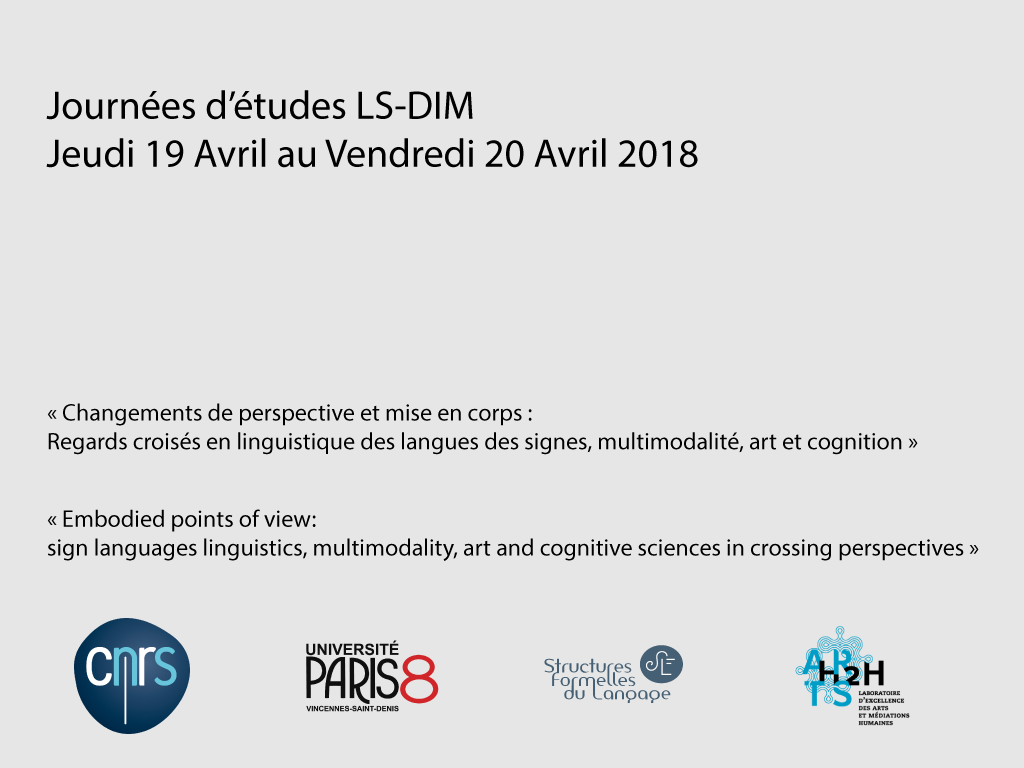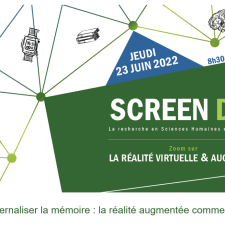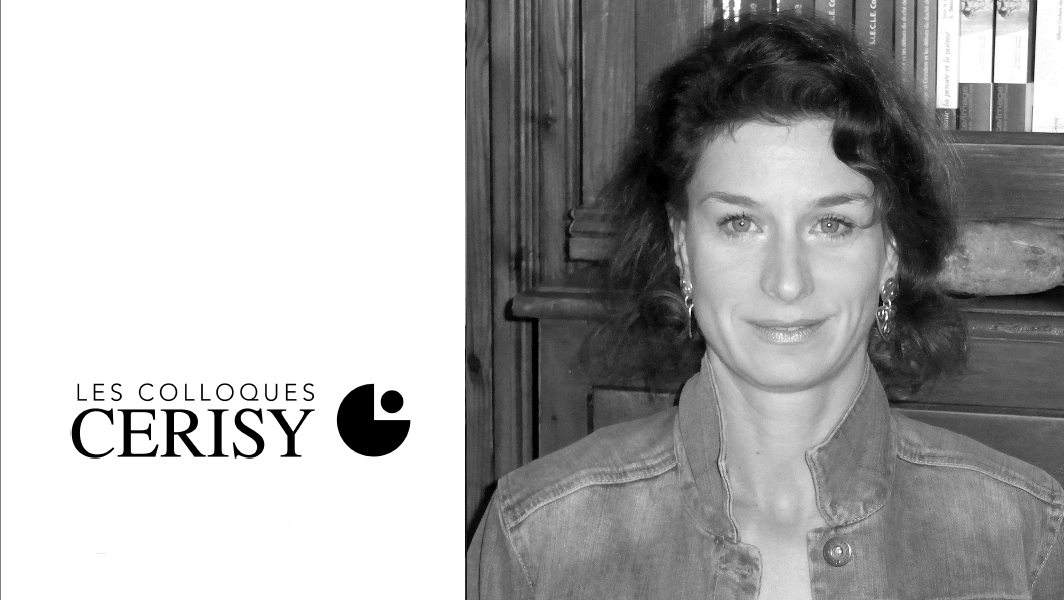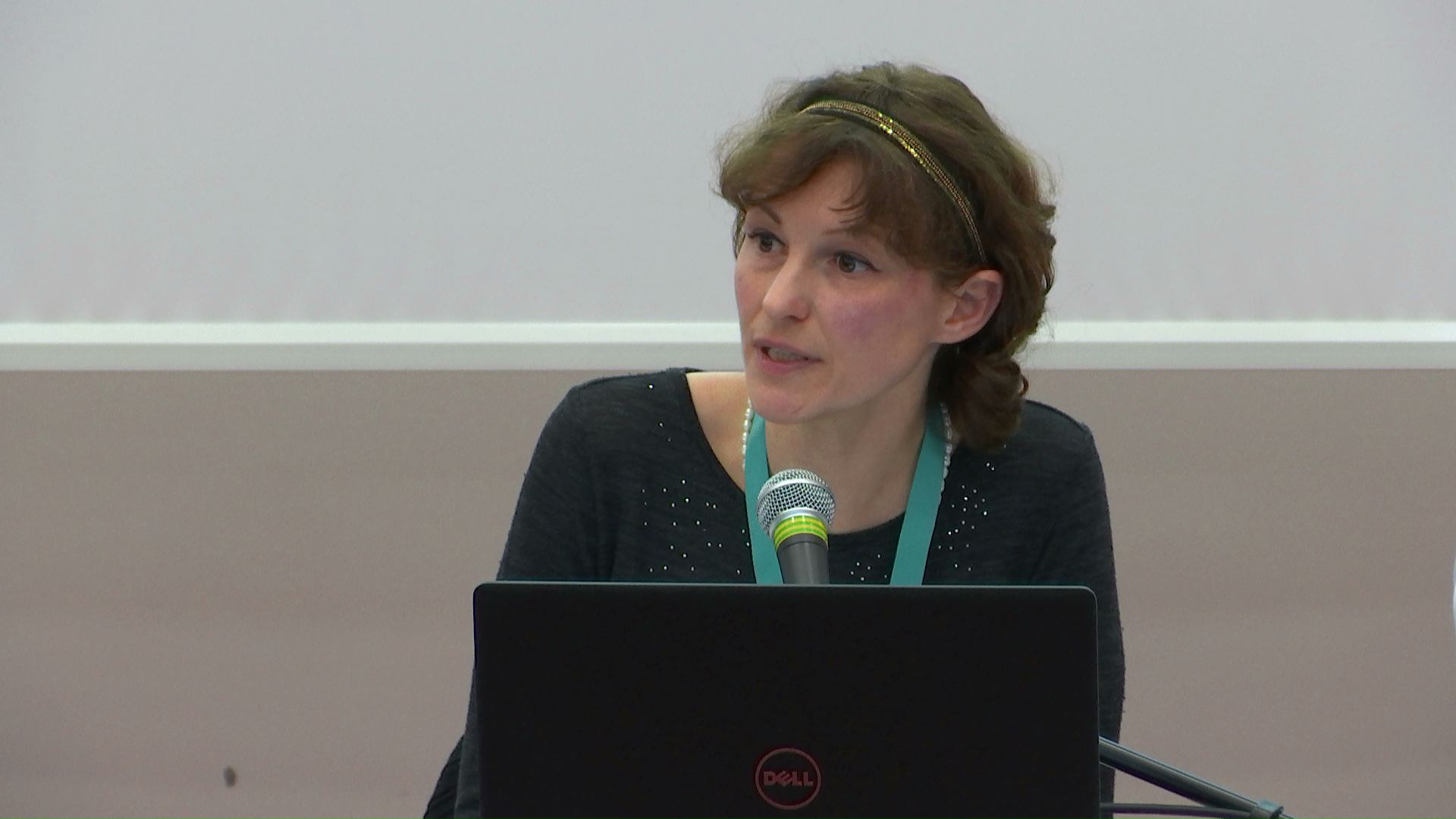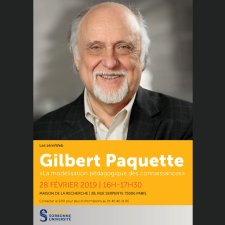Notice
Gestualités coverbale et artistique / Gesture in spoken languages and art
- document 1 document 2 document 3
- niveau 1 niveau 2 niveau 3
Descriptif
Chloé Dechery, Université Paris 8 « To Watch/Witness/Make/Account For –Performance : An Interplay of Relations »
Using and interrogating the notion of the « embodied point of view » as a starting point, this
presentation aims to reflect on performance considered through three different levels:
- as an artistic event, theatrical performance lies upon and encourages the co-presence of heterogeneous, sometimes, conflicted or contradictory embodied points of view. What is performance if not a constantly re-negotiated relation between moving, shifting, unstable embodied points of view? - as a field of research and study - and from an autobiographical perspective – performance stands as a porous field from within I operate in different capacities (as a writer, a performer, a maker, an occasional dramaturge, a spectator, a critic, a theorist and a pedagogue). Thus, performance requires a constant redistribution of my position and the relation I maintain between watching, thinking and doing (what am I looking at? How does it move me? How do I act upon it?) - as a spectacle, performance often sets up its own parameters and spectating conditions, asking, enabling or producing one or plural modes of attention and embodiment from its performers and spectators. In return, it could prove fruitful to ask how my gaze, as a spectator, “performs” or collude with performance, that is what lies in front (or around) me.
Irene Mittelberg, RWTH Aachen University Viewpoint and immersion in multimodal descriptions of imagined pictorial and architectural space: Insights through gesture and gaze
Viewpoint has been shown to be a powerful construal mechanism in multimodal spoken and signed discourse, as well as in various other modalities (e.g., Dancygier and Sweetser 2012; Dudis 2004; Parrill 2009; Stec 2013). This paper investigates embodied viewpoint strategies that have been observed when speakers combine speech, gestures, postures, gaze, and simulated action to describe their interaction with spatial artifacts such as gallery buildings, architectural models, and paintings (Mittelberg 2013, 2017).
‘Simulated artifact immersion’ is introduced as a multimodal viewpoint strategy whereby speakers submerge into their mental representation of a spatial artifact by perceiving and experiencing it from an internal vantage point. It is argued that this viewpoint strategy tends to be employed when there is no narrative structure for the speakers to fall back on.
The paper’s aim is twofold: a) to propose that when speakers talk about their own experiences with spatial artifacts, distinguishing between immersed and non-immersed Experiential Viewpoint strategies (e.g., Sweetser 2013) may be more fitting than distinguishing between Character and Observer Viewpoint (e.g., McNeill 1992); and b) to discuss how considering the interaction of iconic, indexical, and metonymic principles in gesture (Mittelberg and Waugh 2014) may elucidate multimodal viewpoint phenomena in general.
Intervention / Responsable scientifique
Thème
Documentation
Liens
Dans la même collection
-
Table ronde : « Changement de perspective en LS »
BoutetDominiqueDécheryChloéMittelbergIrèneSallandreMarie-AnneGeraciCarloavec la participation de Darren Saunders, Annika Hermann, Marie-Anne Sallandre, Carlo Geraci, Irene Mittelberg, Carlo Cecchetto, Dominique Boutet
-
Table ronde : « Crossing perspectives and cognitive impact in interaction »
BachrachAsafContyLaurenceQuesqueFrançoisCoutteAlexandreLarocheJulienSantoroLizavec la participation de Laurence Conty, François Quesque, Asaf Bachrach, Julien Laroche, Liz Santoro, Alexandre Coutte
-
Table ronde : « Crossing perspectives in coverbal gesture and art »
MacéFannyBlondelMarionDécheryChloéMittelbergIrèneFusellier-SouzaIvaniKuhnJeremyTable ronde : « Crossing perspectives in coverbal gesture and art » avec la participation de Chloé Dechery, Irene Mittelberg, Jeremy Kuhn, Ivani Fusellier, Fanny Macé, Marion Blondel
-
-
Cognition and interaction
ContyLaurenceQuesqueFrançoisLaurence Conty, Laboratory of Artificial and Human Cognition (CHArt), University of Paris Nanterre "Other’s gaze in human cognition: effects, mechanisms and therapeutic potential" François Quesque,
Avec les mêmes intervenants et intervenantes
-
Table ronde : « Crossing perspectives in coverbal gesture and art »
MacéFannyBlondelMarionDécheryChloéMittelbergIrèneFusellier-SouzaIvaniKuhnJeremyTable ronde : « Crossing perspectives in coverbal gesture and art » avec la participation de Chloé Dechery, Irene Mittelberg, Jeremy Kuhn, Ivani Fusellier, Fanny Macé, Marion Blondel
-
Table ronde : « Changement de perspective en LS »
BoutetDominiqueDécheryChloéMittelbergIrèneSallandreMarie-AnneGeraciCarloavec la participation de Darren Saunders, Annika Hermann, Marie-Anne Sallandre, Carlo Geraci, Irene Mittelberg, Carlo Cecchetto, Dominique Boutet
Sur le même thème
-
Exposition à une langue des signes de personnes avec troubles du spectre de l’autisme : bilan des r…
ShieldAaronVanbruggheAnneCruveillerVirginieGérardChristelleJournée d’études sur les thèmes associés de la langue des signes française (LSF) et des troubles du spectre de l’autisme (TSA), dans le cadre d’une recherche en cours sur les interactions gestuelles,
-
Externaliser la mémoire : la réalité augmentée comme prothèse cognitive
Présentation orale de travaux de recherche par Nicolas CROZATIER (UGA, IPhiG/CPM) lors de Screen Day 2022.
-
Pour en finir avec l’impressionnisme littéraire. Un essai de métastylistique
À travers le cas de l'impressionnisme littéraire, cet article se propose d'interroger une forme de « réalisme » qui s'est construite sur « un rapport au référent orienté par la notion de fidélité »
-
Quand avons-nous besoin de la moralité ?
Une réflexion sérieuse sur l’empathie ne peut négliger les nombreuses recherches qui montrent que les expressions émotionnelles des membres d’un "hors-groupe" ne suscitent pas la même résonance
-
Language within the mosaic of social cognition
In spite of high genetic overlap and broadly similar neural organization between humans and non-human primates, humans surpass all other species in their abilities to solve novel problems, in the
-
L'intelligence animale : exemple des corvidés
DufourValérieValérie Dufour, chargée de recherche au CNRS, discute dans cette vidéo de la cognition animale, en se focalisant sur l'exemple des corvidés qui regroupent par exemple les pies, les geais ou
-
La réalité virtuelle 3D en soutien des apprentissages de langues : le rôle du contexte de communica…
CiekanskiMaudPrivas-BréautéVirginieCette recherche interroge le renouvellement des situations d'apprentissage avec l'entrée des mondes virtuels en 3D dans l'éducation. L'immersion (parfois appelée « bain linguistique ») a
-
SémiWeb - la modélisation pédagogique des connaissances - Gilbert Paquette
PaquetteGilbertCette conférence de Gilbert Paquette présente la modélisation pédagogique des connaissances
-
Table ronde : « Changement de perspective en LS »
BoutetDominiqueDécheryChloéMittelbergIrèneSallandreMarie-AnneGeraciCarloavec la participation de Darren Saunders, Annika Hermann, Marie-Anne Sallandre, Carlo Geraci, Irene Mittelberg, Carlo Cecchetto, Dominique Boutet
-
Table ronde : « Crossing perspectives and cognitive impact in interaction »
BachrachAsafContyLaurenceQuesqueFrançoisCoutteAlexandreLarocheJulienSantoroLizavec la participation de Laurence Conty, François Quesque, Asaf Bachrach, Julien Laroche, Liz Santoro, Alexandre Coutte
-
Table ronde : « Crossing perspectives in coverbal gesture and art »
MacéFannyBlondelMarionDécheryChloéMittelbergIrèneFusellier-SouzaIvaniKuhnJeremyTable ronde : « Crossing perspectives in coverbal gesture and art » avec la participation de Chloé Dechery, Irene Mittelberg, Jeremy Kuhn, Ivani Fusellier, Fanny Macé, Marion Blondel
-


